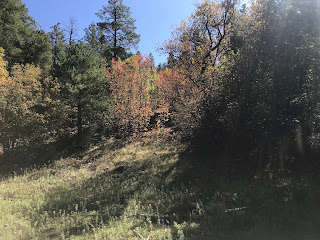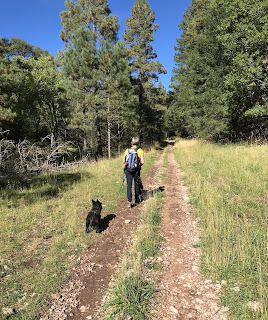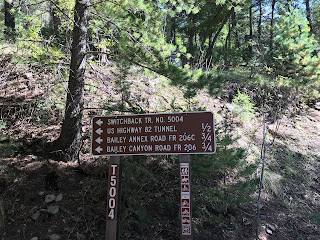
Over the last 6 or 7 years I've been making an effort to hike most of the official trails in the Sacramento District of the Lincoln National Forest. I'm not going for them all. There some that just don't appeal to me and I don't have that obsessive completion complex that motivates many hikers. Still, I've done around 60 and probably have a few more that I want to see. It's been fun.
The four trails out in the Piñon Draw area in the remote southeast corner of the district have been on my radar for years, but they are so far and gone that they are not really convenient for a day hike, if the day includes driving back and forth from Las Cruces.
On the long weekend, we were camping this year, as we did last year, on a friends property by the Peñasco River near Mayhill. I figured this as close as we are going to get. It still took 45 minutes to get out to the trailheads we used. The only way to get really close would be to camp in one of the many clearings along the Piñon Draw Road ( FR 183), but as we observed on that first day, they were jammed full of huge fifth wheels and trailers and the hopeful hunters who brought them there. As is now well known to us, the population of even the most remote ranching country or forest canyons and ridges of the Lincoln National Forest, increases dramatically once the hunting season begins.
Just past the largest of clearings, which was almost like little town with hunters and families bustling about, is Forest Road 253( which I'll deal with in another blog). About a 1/2 mile past FR 253 is a worn brown sign for Long Canyon. After crossing the dry stream bottom, Forest Road 557 was on our left. Call it what you will, "primitive, un-maintained", FR 557 was a bit of an adventure. High clearance is most definitely needed, and if there has been even a meager amount of moisture, four wheel drive will become necessary. Narrow, bumpy, occasionally muddy, with many crossings of canyon bottom, the 3-4 mile drive took around twenty minutes. Funny thing is, as bad as it was, we didn't know how good we had it until we drove on FR 253 the next day.
We parked just across from a final crossing with the trailhead signs visible beyond. Some black cows and calves were milling about a small circular drinking trough. Nearby were stacks of guided missile canisters, I'm guessing that were used to store water or molasses for the cattle.


We walked the last bit of road to the trailhead that serves for both the Lick Ridge Trail ( FT 9666A) and the Long Canyon Trail ( FT 9652 ). We started up Long Canyon on the right. The "trail" is an old logging road, of course, now greened over with clover, and grass, that follows along and frequently crossed the narrow streambed that cuts through thick layers of gray and tan limestone. Well shaded by pines and oaks it's a pleasant, if unremarkable forest walk. Its best qualities are the easy walking and the complete solitude.


We were occasionally hearing some elk bugling, and eventually were getting so close that I knew we were going to either see a bull elk or some hunters in pursuit. Turns out it was the latter. I saw them on the canyon side above us at about the same the saw us. I don't know if I ruined their morning, now that they realized their calling was in vain. Oh well, we kept on walking.
Eventually the trail begins climbing more earnestly. White and douglas firs appear on the hillsides, while on the ground the road begins to disappear. We stuck with the canyon course until we were on top of the sunny ridge with scattered pines and a thick undergrowth of brushy oaks. At this point there was no trail at all but I knew we were very close to meeting up with FR 253. We ran into the remains of a wooden frame work (for a deer blind?) now mostly concealed in the low growing oak and then directly ahead a few hundred feet or so was the road. This upper trailhead is unsigned, which is one of several reasons I strongly recommend doing this hike from the lower. We turned to our left and now began our 1.2 mile walk along the clay and gravel forest road on top of Lick Ridge.
It was a bit warm at the noon hour and there was little shade except for the occasional roadside juniper, so the walk, although mostly level, seemed long. My wife was keeping track with her I-watch and precisely at the appointed mileage appeared the signed trailhead for the Lick Ridge Trail. Despite having the marvelous, sturdy metal signage that was installed all over the Lincoln a few years back, there has been no effort to actually cut a trail of any kind on behind it. We had walked only short ways when we saw a small carsonite sign pointing to our right and an old road going straight ahead. We consulted Lynn Melton's trail description from her Sacramento Ranger District Trails website. We still weren't too sure and began to walk a bit on the road. That felt wrong to me, so I veered everyone back to right and we quickly encountered the first of many pink ribbons that I had strong feeling were indicating the route of FT 9666A. They led us to a tributary watercourse that started very narrowly and steeply but then expanded to a size where some remnants of an old roadway came and went. This little canyon was very sweet to me. The highlight here was a clearing with many bigtooth maples along its edges, and tall conifers rising above. Unfortunately they were yet to transform to blazing red, pink, and yellow ( even though it was a week later) as the ones we had encountered last year had done. Aah, such are the vagaries of pursuing fall color in southern New Mexico

We ate our late lunch in a shady spot nearby.
The canyon leveled out beyond and followed a more obvious old two track for awhile. We had to give a wide berth to that same group of black cows who were now standing in our path and acting a bit ornery to boot ( our dogs and the half-wild cattle of Lincoln seem to have mutual hostility, I'm not sure why). We stayed straight with the canyon bottom when a well traveled road appeared on our right and were soon back at the trailhead finishing our little 5 mile loop.

Labels: fall colors, hiking



































































